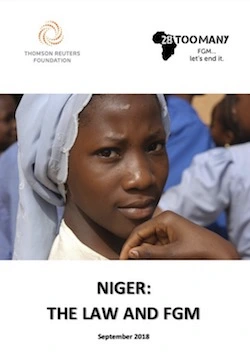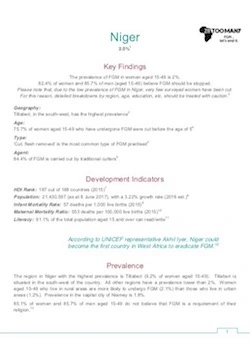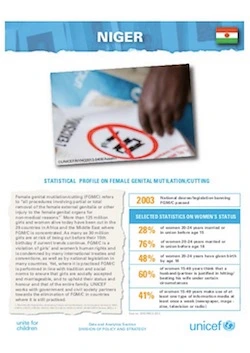Home | Research & Resources | Niger
Key Findings
The prevalence of FGM/C among women aged 15–49 in Niger is 2.0%.
82.4% of women and 90.6% of men (aged 15–49) believe FGM/C should be stopped.
Geography
Tillaberi, in the south-west, has the highest prevalence
Age
75.7% of women aged 15–49 who have undergone FGM/C were cut before the age of 5
Type
‘Cut, flesh removed’ is the most common type of FGM/C practised
Agent
84.4% of FGM/C is carried out by traditional cutters
Distribution of FGM/C across Niger
The region in Niger with the highest prevalence is Tillaberi (9.2% of women aged 15–49). Tillaberi is situated in the south-west of the country. All other regions have a prevalence lower than 2%. Women aged 15–49 who live in rural areas are more likely to undergo FGM/C (2.1%) than those who live in urban areas (1.2%). Prevalence in the capital city of Niamey is 1.8%.
85.1% of women and 85.7% of men aged 15–49 do not believe that FGM/C is a requirement of their religion.
Between 2006 and 2012, survey data suggests that the overall prevalence for women aged 15–49 fell from 2.2% to 2%, however this drop is not statistically significant. One should therefore assume that the prevalence remained constant at around 2%. In 2006, 88.9% of women and 86.2% of men aged 15–49 who have heard of FGM/C stated that they believed FGM/C should be stopped; in 2012, those figures were 82.4% and 90.6% respectively.
Please note that, due to the low prevalence of FGM in Niger, very few surveyed women have been cut. For this reason, detailed breakdowns by region, age, education, etc., should be treated with caution.
FGM/C Legislation in Niger
The main law prohibiting FGM/C in Niger is Law No. 2003-025 (the Penal Code), adopted in June 2003. There have been few prosecutions for FGM/C in Niger; knowledge of the law and enforcement remain weak across the country.
Development Indicators
Population Growth
21,430,597 (as at 8 June 2017), with a 3.22% growth rate (2016 est.)
Infant Mortality
57 deaths per 1,000 live births (2015)
Maternal Mortality
553 deaths per 100,000 live births (2015)
SDG Gender Index
Ranked 140 out of 144 countries with a score of 43.3% (2022)


.webp)
_cover.webp)
_french_cover.webp)

_french_cover.webp)

.webp)

_french.webp)